Abandoned Charming Village; Levissi (Kayaköy) / Terk edilen Büyüleyici Köy; Levissi ( Kayaköy ) EN/TR
EN
Hello, Dear Travelers,
Today, we will take you through the history of historical houses built on a hillside, half of which were damaged and the other half were completely destroyed. When I saw this ghost village that completely covered the mountain slope, I tried to feel the memories accumulated in these houses. It may not be a popular spot in Fethiye, but I think it is one of the rare spots that can fascinate everyone after seeing it.
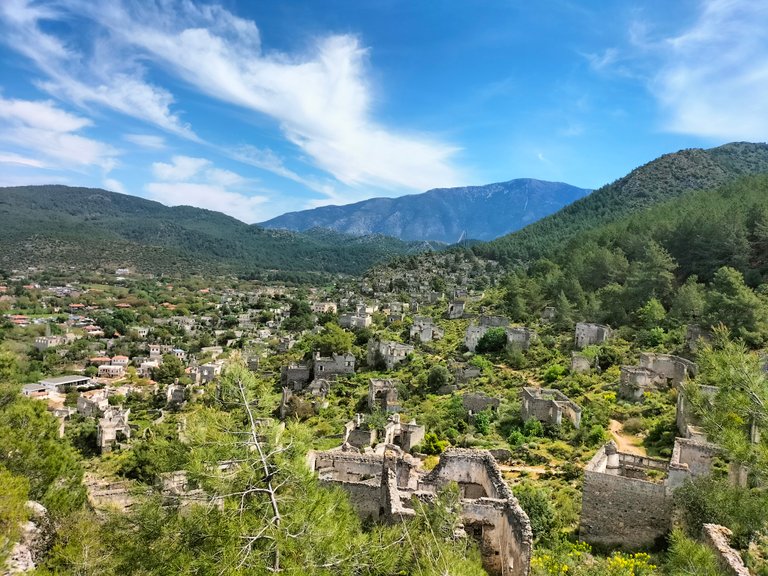
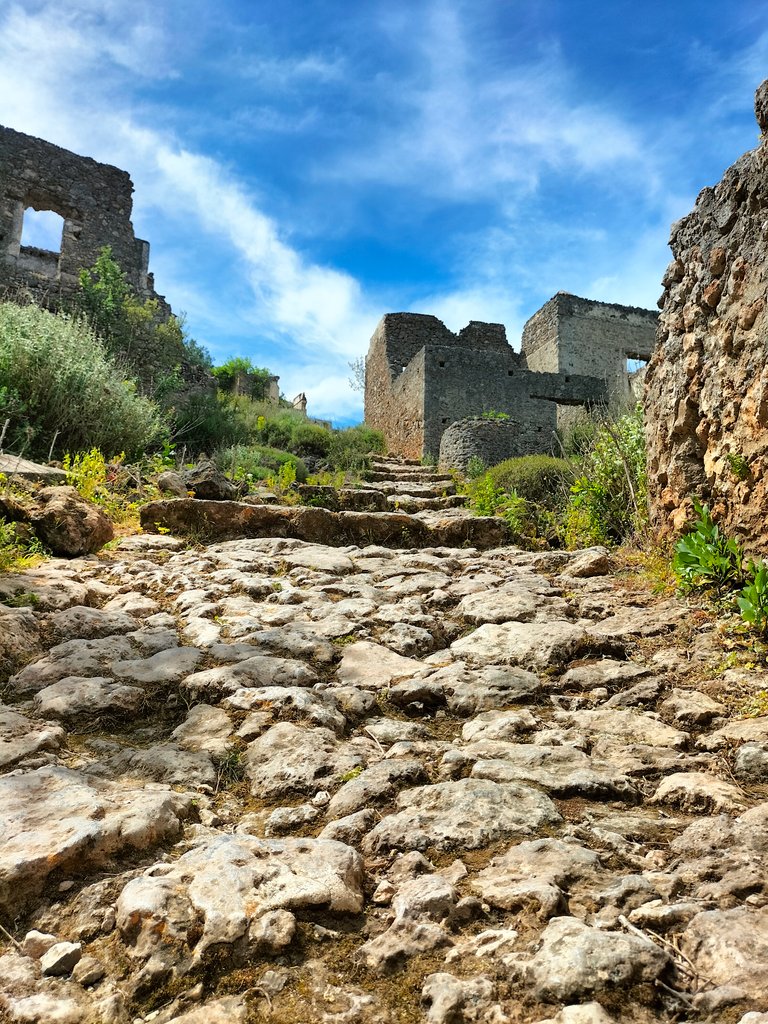
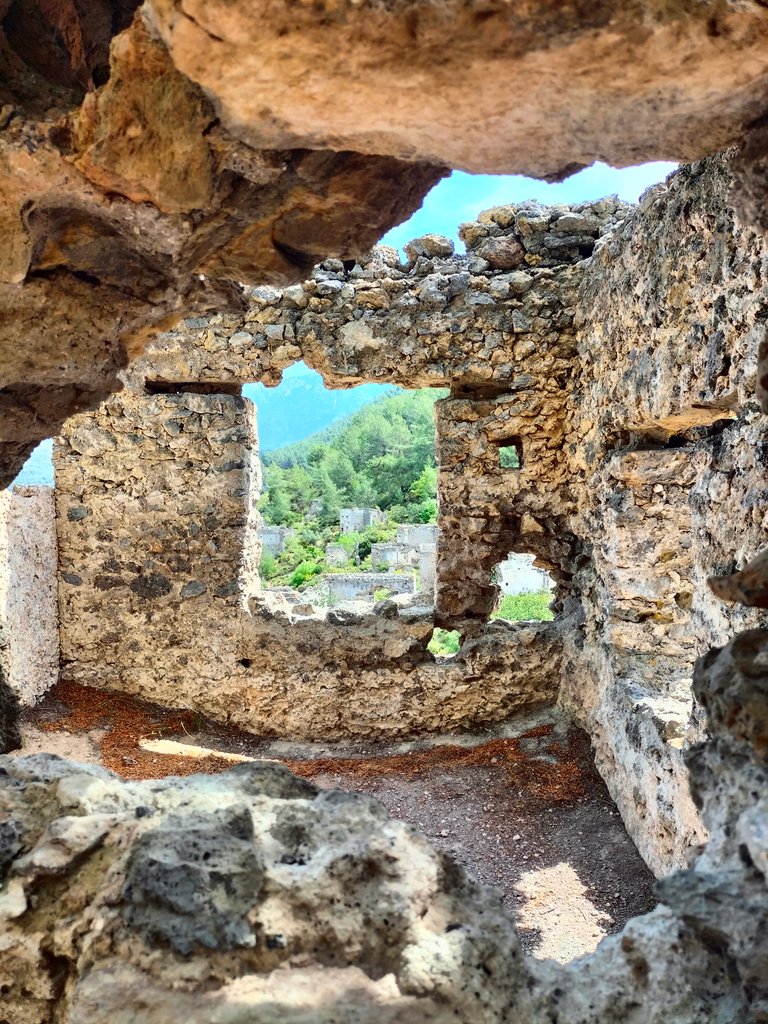
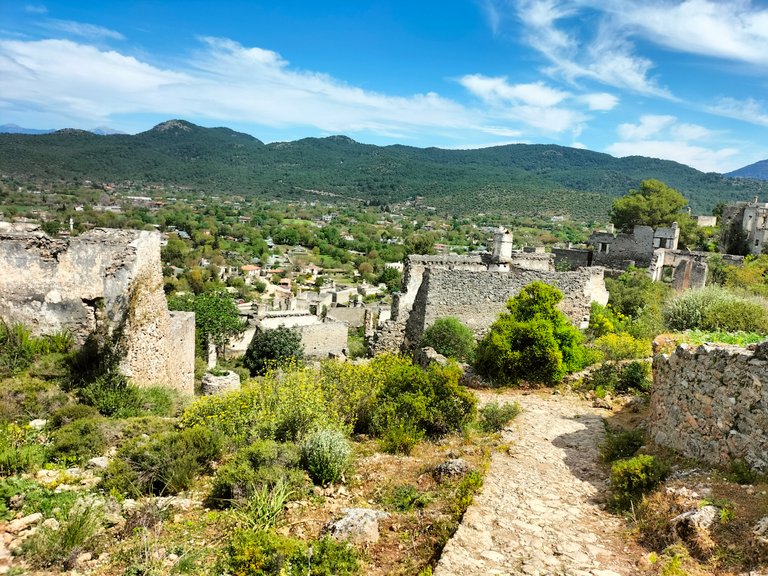

I'm sure you will be amazed when you see the ruined houses resembling small pieces of rocks in the magnificent nature and greenery. Now, we will explore every corner of these dilapidated houses, with no roofs or paint, and discover their history and all their beauty. But first, let's talk about how we got here. If you want to come here by plane, you can use the nearest Dalaman Airport in Turkey. Kayaköy, that is, Ghost Village, is located in the Fethiye district of Muğla province. You can reach here from Fethiye city center in about 10 minutes with your own car. Its location is between Fethiye and Ölüdeniz. When you set out from Fethiye, you can reach here by following the road to Kayaköy and after passing a few winding mountain roads. Like me, coming from Antalya to Ölüdeniz, you can easily reach here by passing through the Hisarönü neighborhood to go to Kayaköy.





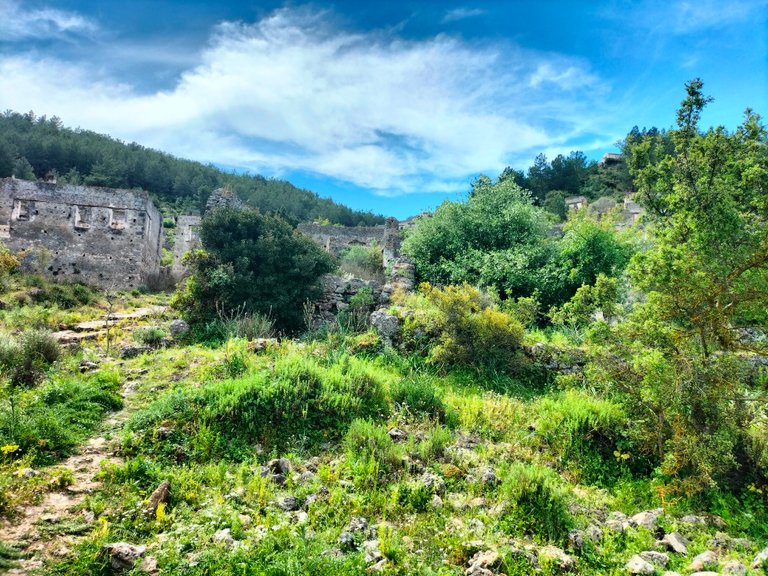
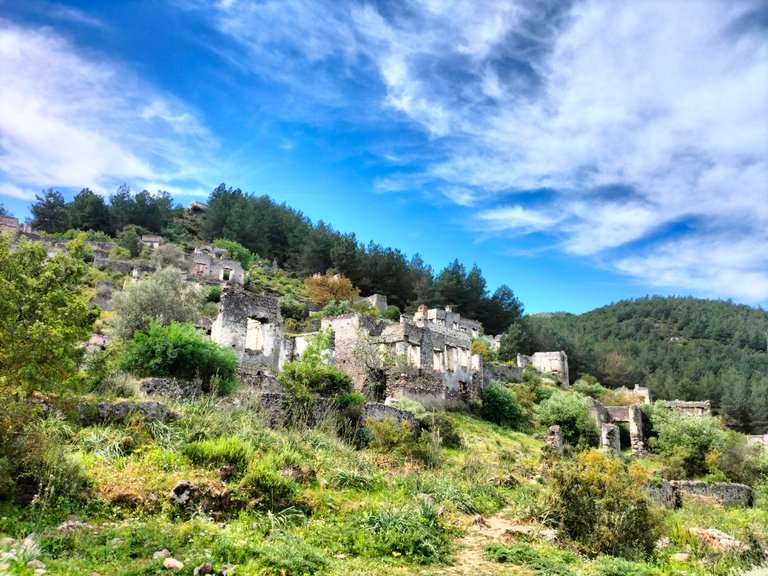
There is a very nice business right at the entrance of Kayaköy. It attracts attention with its cushioned seating cabins placed among trees and greenery. All kinds of souvenirs, both unique to the village and of interest to everyone, are sold inside. By entering from here, we come to the box office area. They demand 85 TL as an entrance fee to the Ghost Village. So, you can think of it as around 8 Hives. After passing through the toll booth, there is a historical church on the left. They banned entry into this historical church, known as the Lower Church. The church was used as a mosque long ago, but was later converted into a church. Surrounded by high walls, the church was built using patterned mosaics of black and white old stones. Marble was used in the doors and windows. The windows are closed with iron mesh. There are five short arched entrance sections standing side by side on the roof. A large cover was built in the middle of the roof on the round minaret capital. The patterned mosaic stones in front of the entrance door appear to have been carefully made. Even though I couldn't get into the church, I tried to take some photos for you, even from a distance.
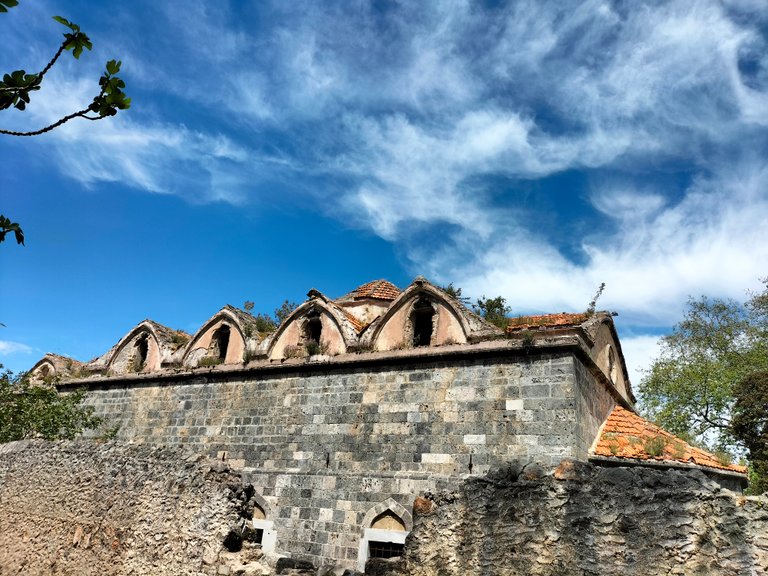

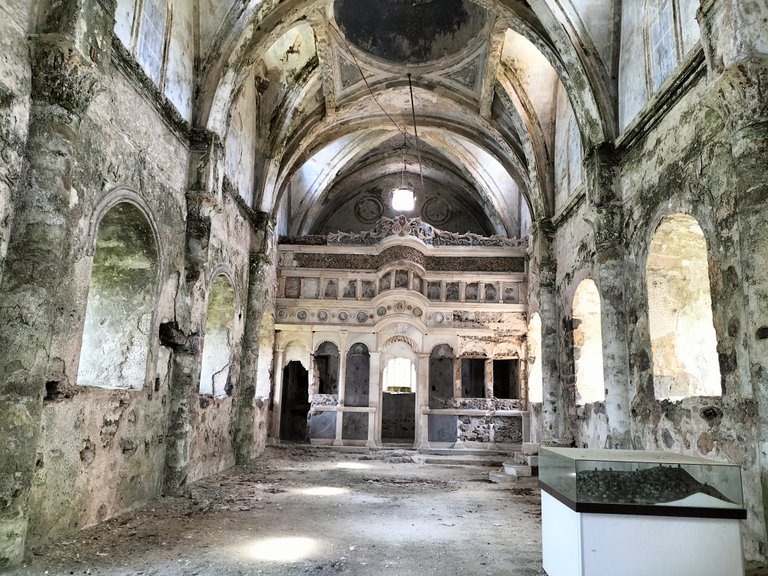
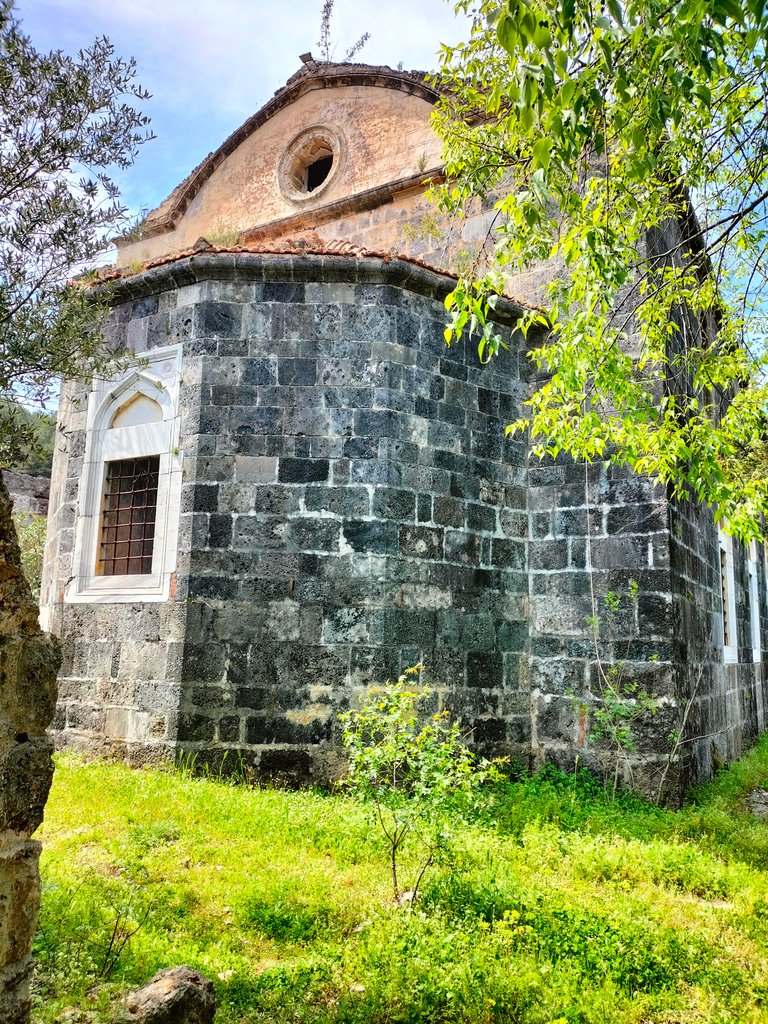



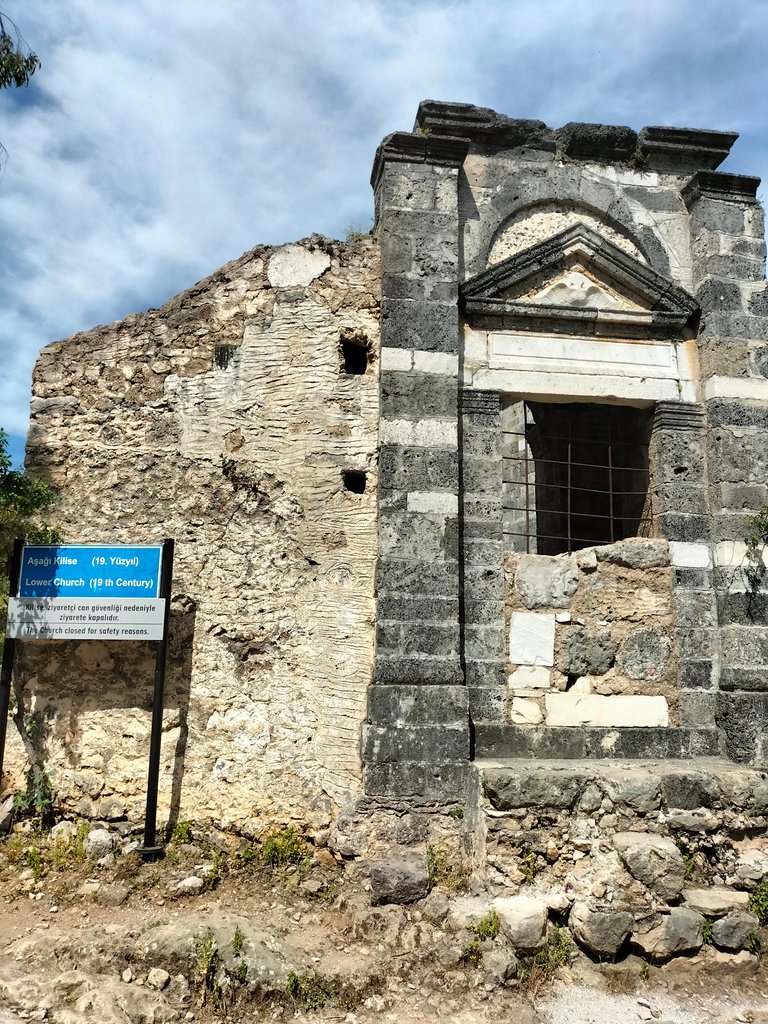



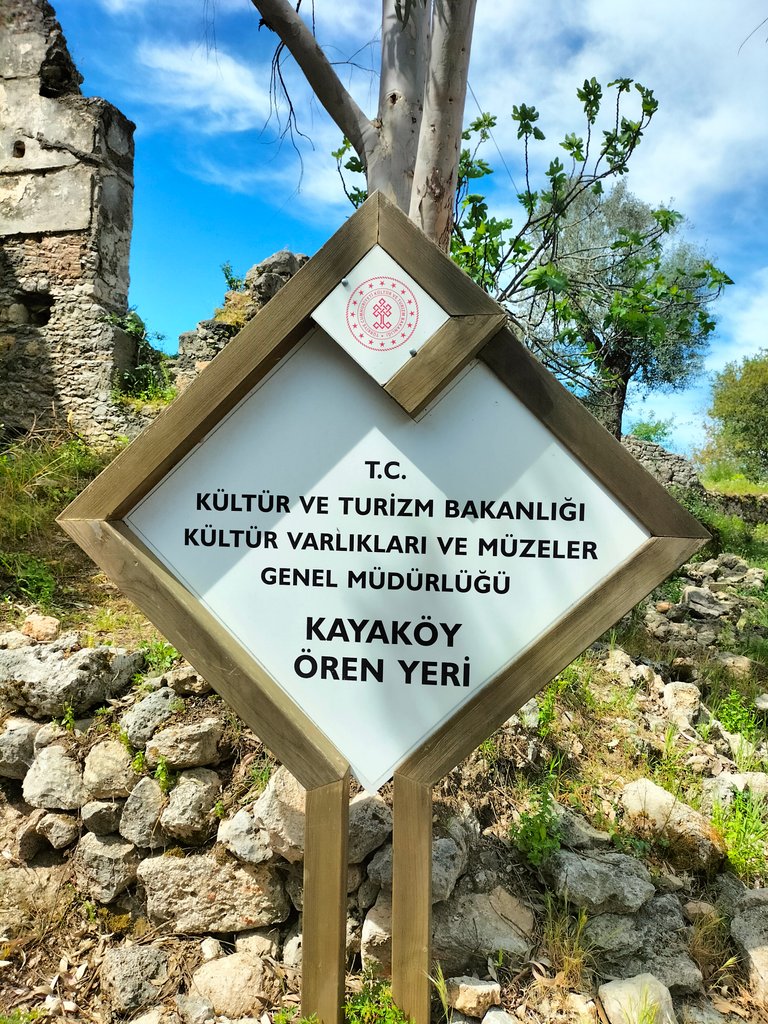
Every time I come to visit historical places, I always buy a magnet or any souvenir to keep as a memory. From here, we entered the ruins by purchasing two magnets.


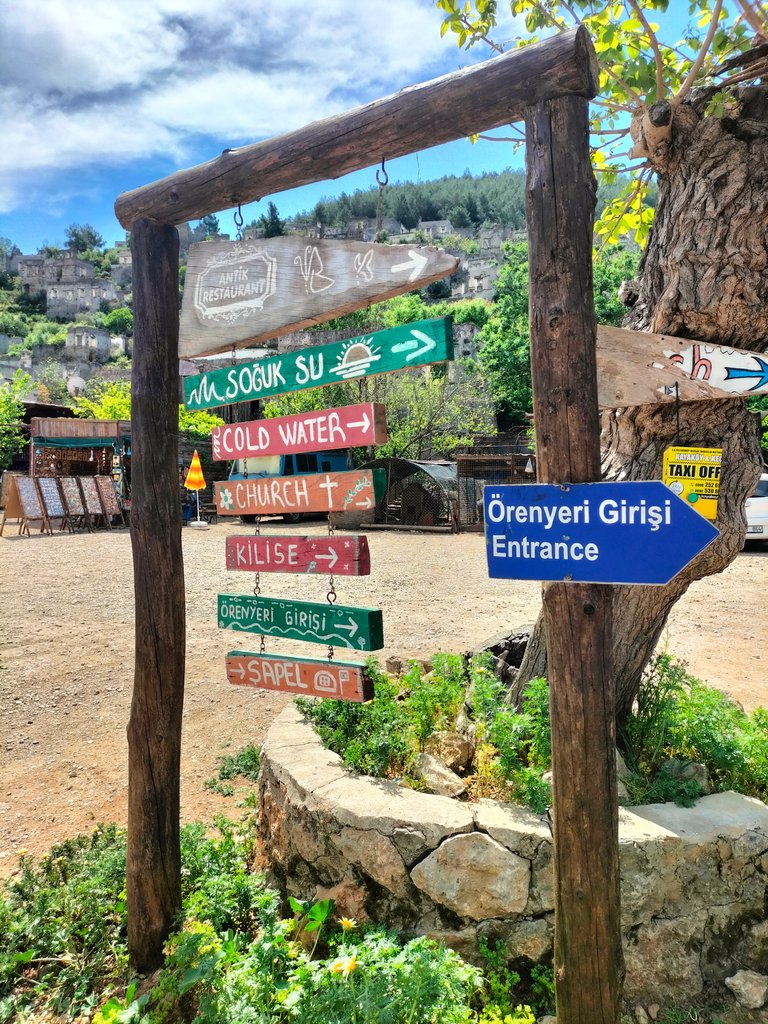

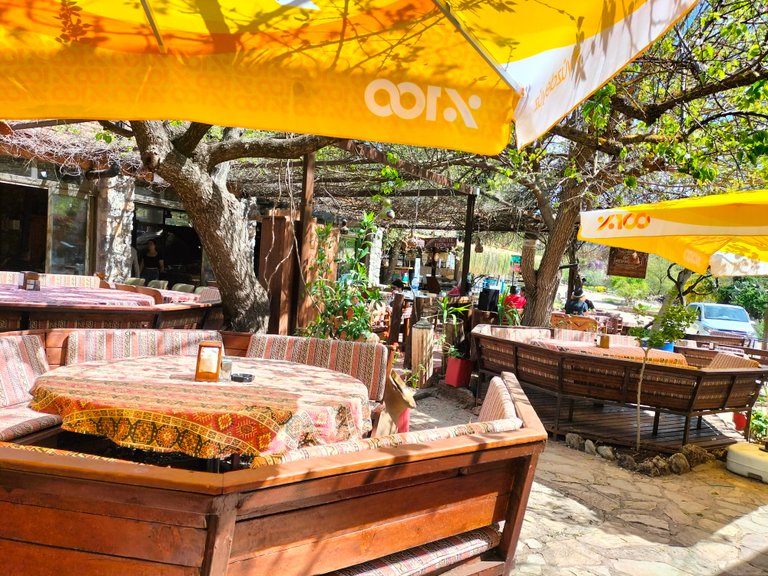
We enter the village from the wide, stony road right next to the toll booth. Before we start wandering around, let's take a look at what is written on the information board about Kayaköy.

Although the history of Kayaköyü, known as Karmylassos in ancient times, dates back to 3 thousand BC according to philological data, no finds dating back to the 4th century BC have yet been found in the ruins. The houses built on the slopes of the city belong to the Greek settlement, which was built in the second half of the 19th century and the first quarter of the 20th century and was called Levissi in those years. In addition to the houses, which do not block each other in terms of view and light and most of which are 50 m2 in size, there are 14 chapels, 2 churches, 2 school buildings and 1 customs building. There are hollow elements used in leather production in the windowless and low basements of houses. We also learn that there are stoves and appliances around them used for heating and cooking in almost every room of the house.

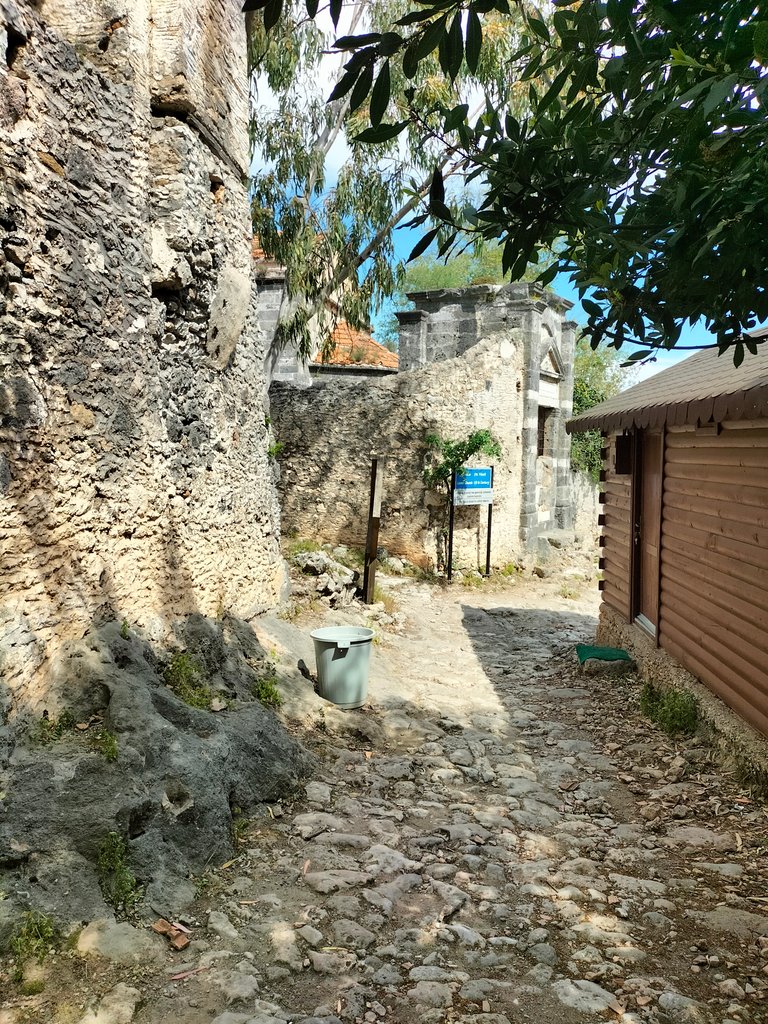
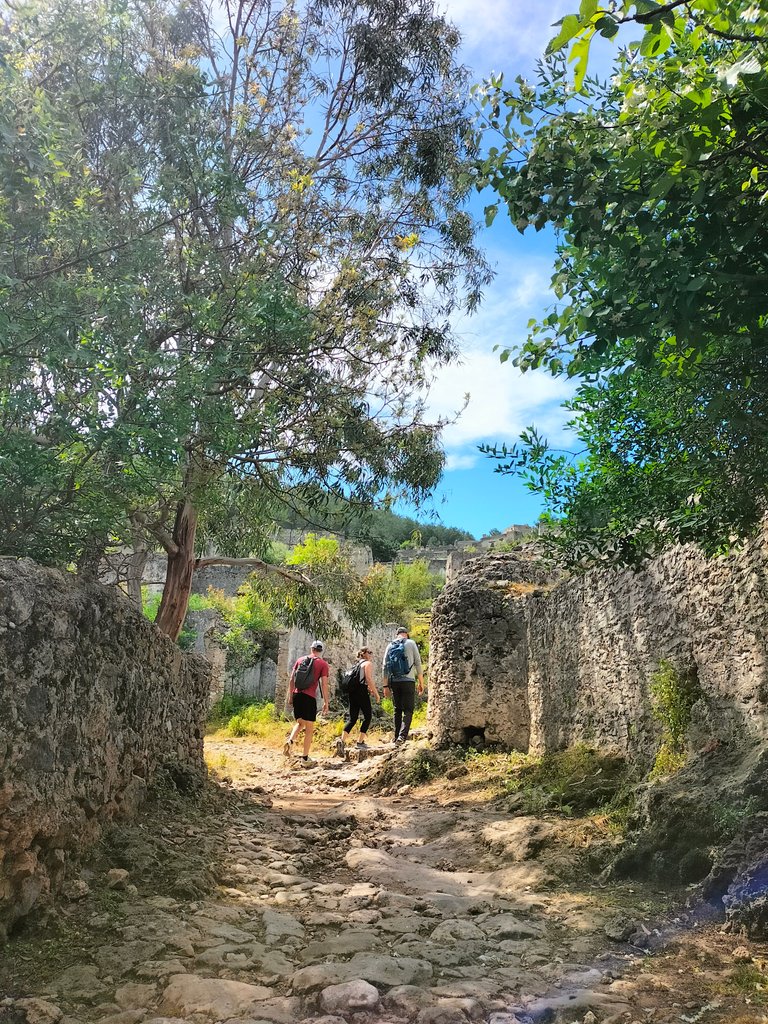
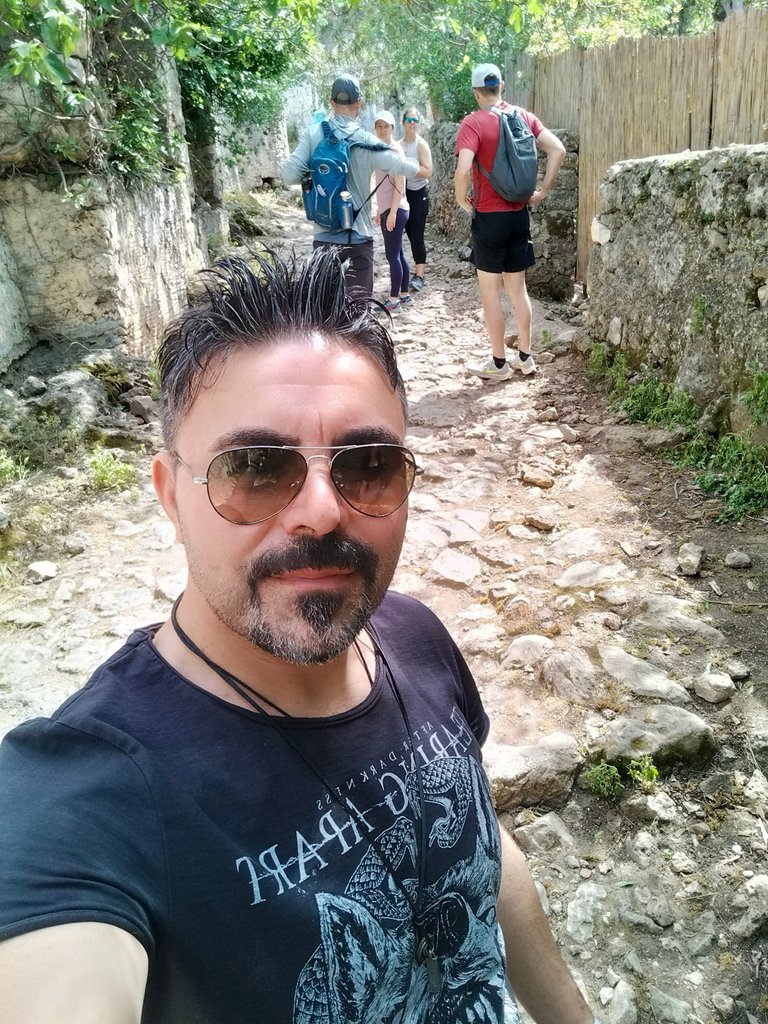
When I talked to a couple of local tradesmen at the entrance, they said that I came here just in time for the season. That's exactly what happened. In the middle of April, we had the opportunity to see the beautiful flowers and greenery that spring offered to nature, among the collapsed houses and stones. The fact that the trees growing in the gardens of abandoned houses and those who planted their seeds migrate from these places without seeing their fruits leaves us in the middle of a truly sad story. Kayaköy is built on a mountain slope. Destroyed and damaged Greek houses can be seen left and right along the slope. At the top, there is a historical building with a Turkish flag, reminiscent of a mill building.
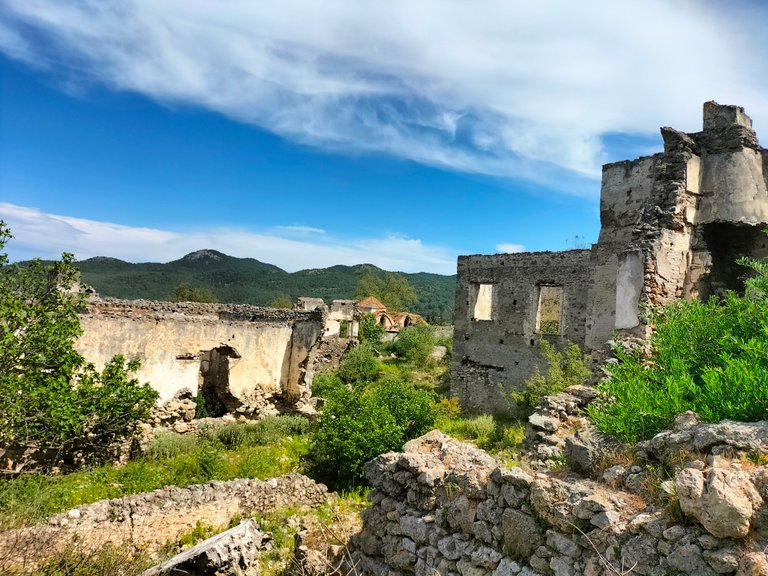
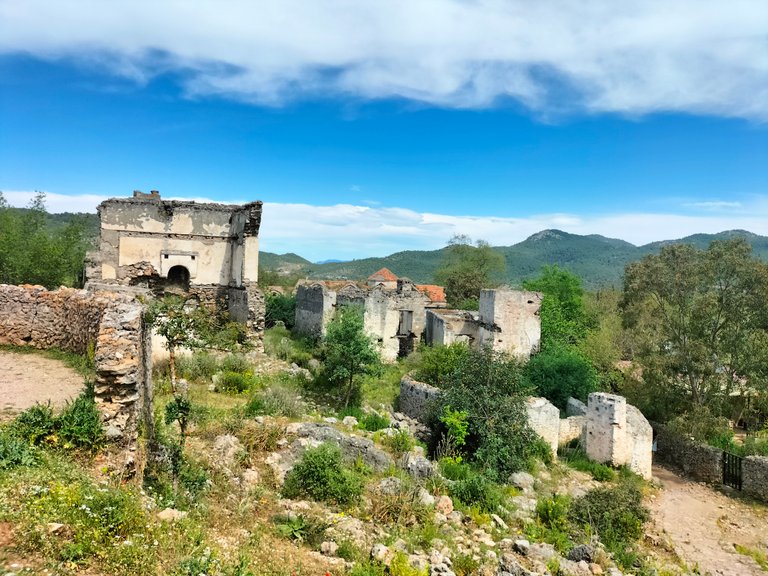
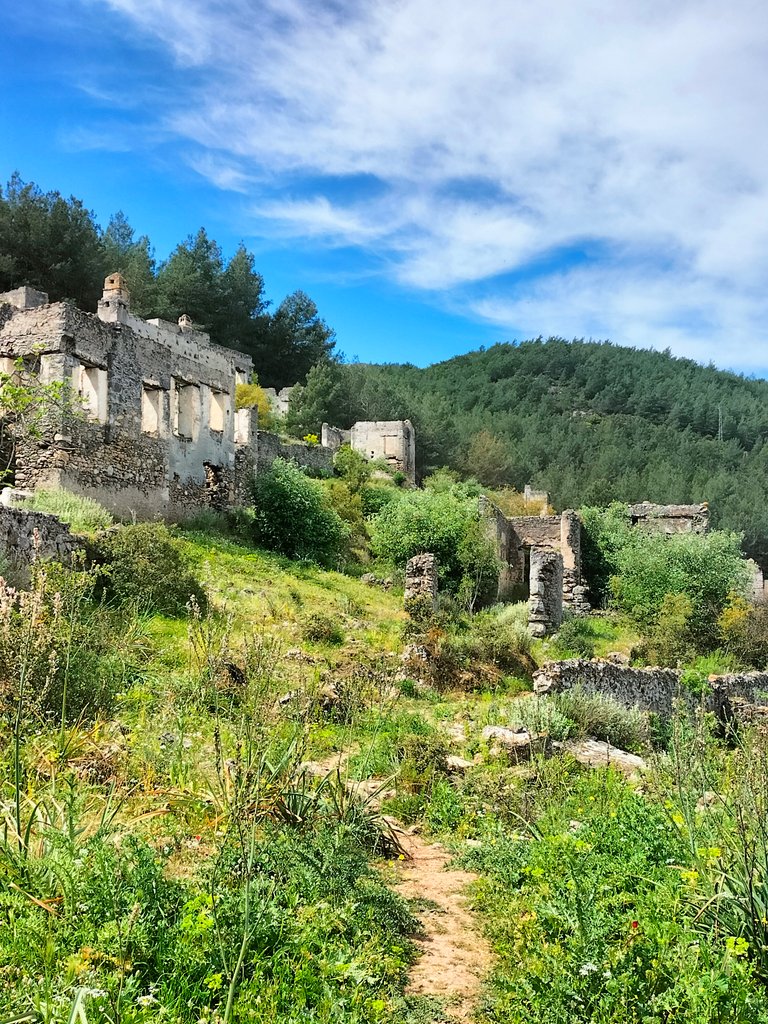
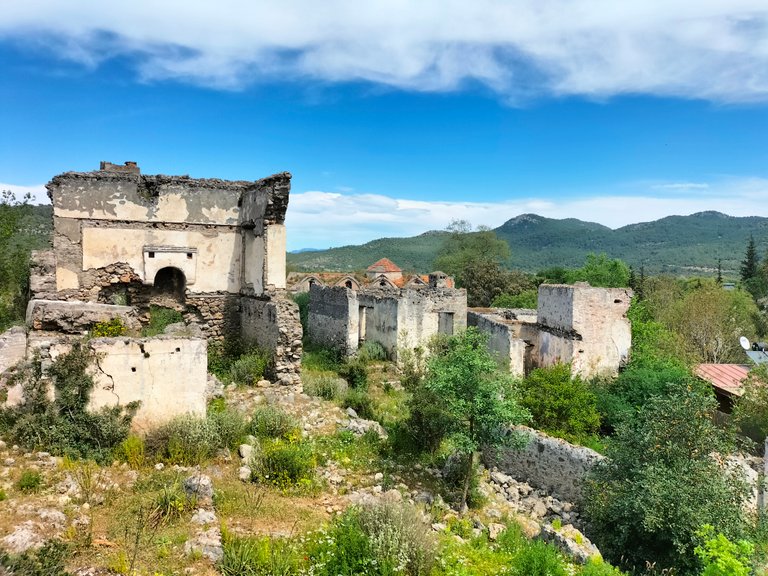



There are steep roads with indentations and protrusions made of rocks and stones inside the village. These roads take us to the gardens of the houses. You can smell the rocks in the gardens and the plants and herbs inside the houses. By wandering around among the stone houses built by the Greeks, I can say that every destroyed and abandoned building looks similar to each other. We try to reach the hill where the view is most beautiful by walking through the narrow stone streets of the village. While walking, we enjoy the houses and the beauty around them.
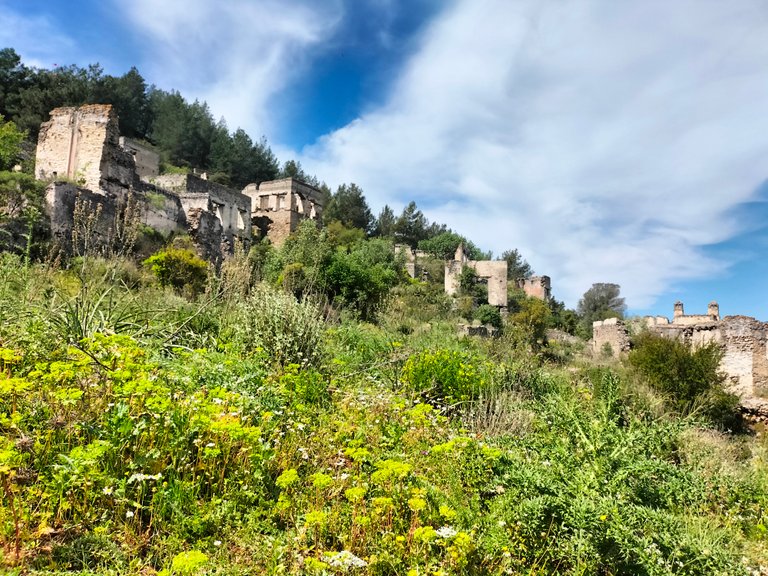

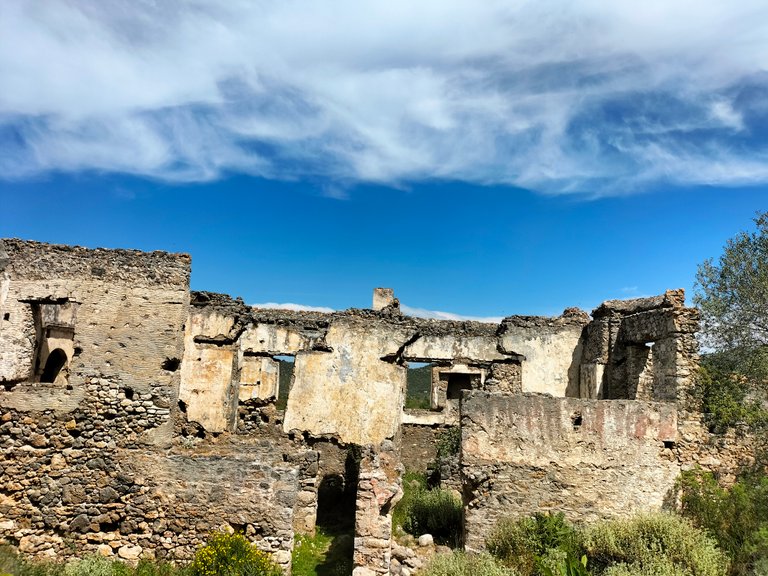
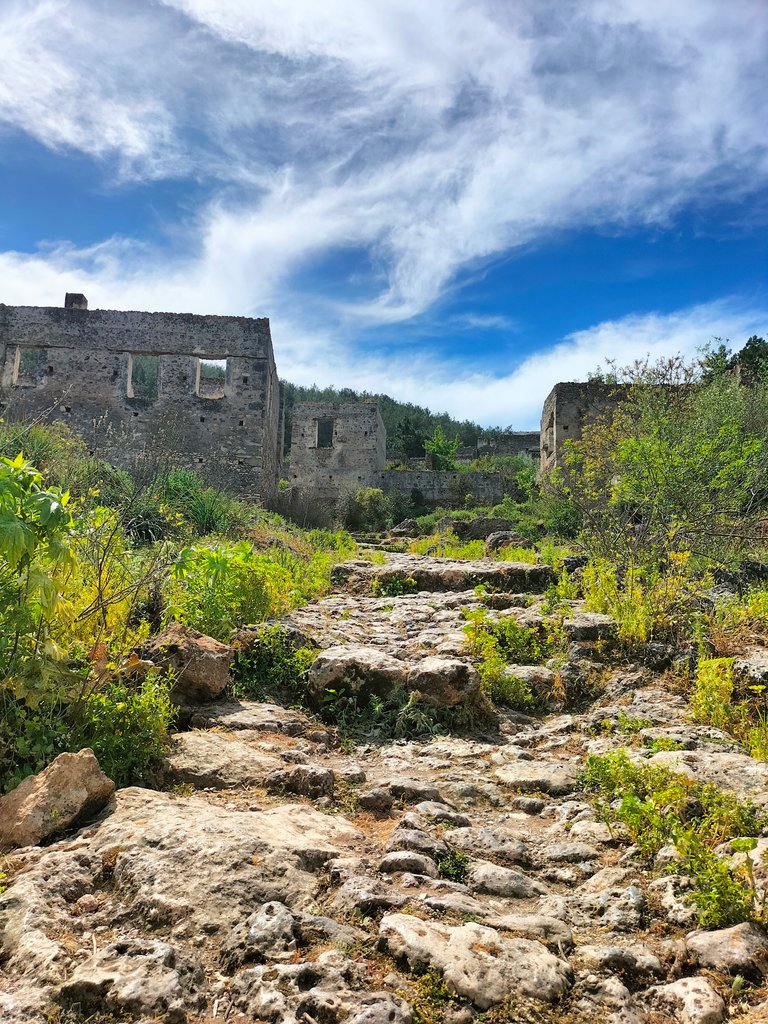

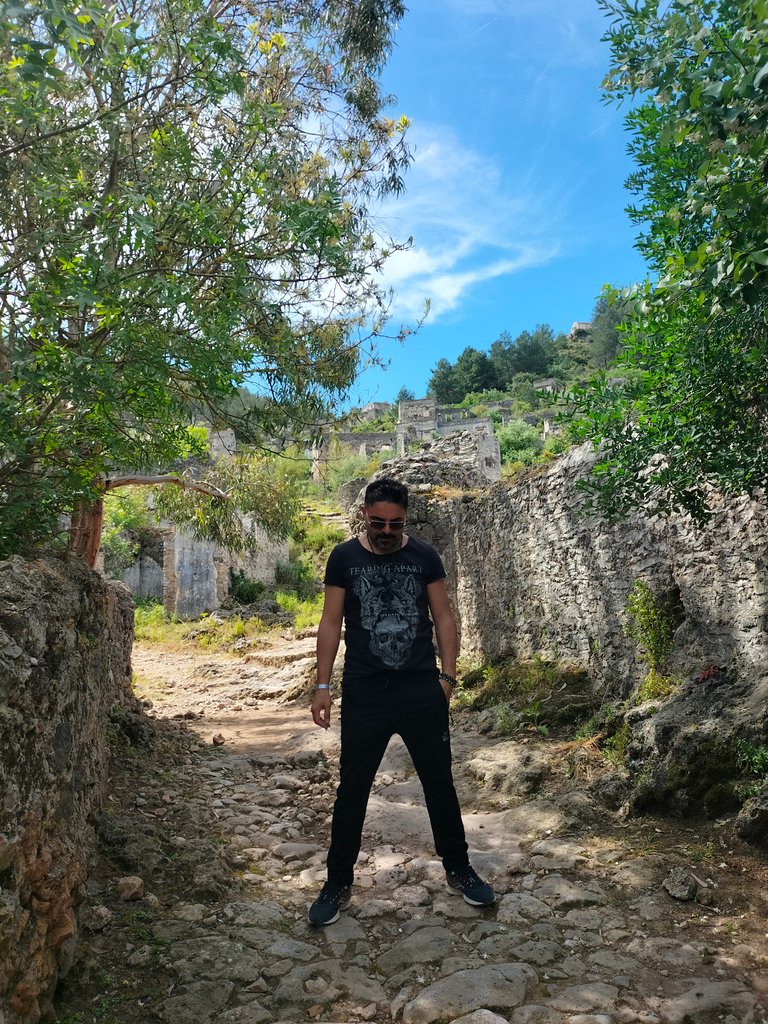

Most of the houses in this abandoned village are two-storey, and some houses have tanks at the entrance to collect water. Most likely, the Greeks wanted to create an area where they could collect rainwater. As you walk along the narrow, steep rocky roads, you are fascinated by the greenery around you. You may also notice that there are different types of trees found in between. I think this abundance of greenery and tree species is due to the fact that it is in an area where Aegean waters and Mediterranean waters intersect. I can say that the appearance of the houses lined up on the hillside among the greenery together with the white clouds reveals paintings that will be works of art.
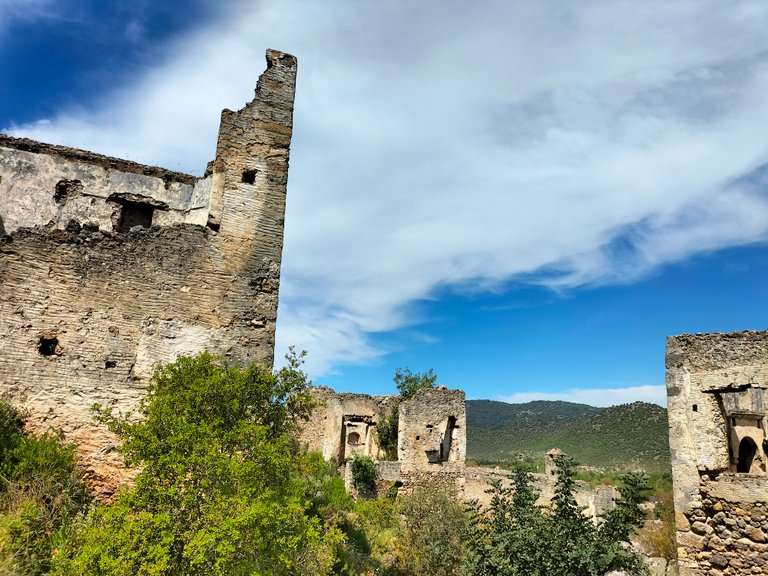
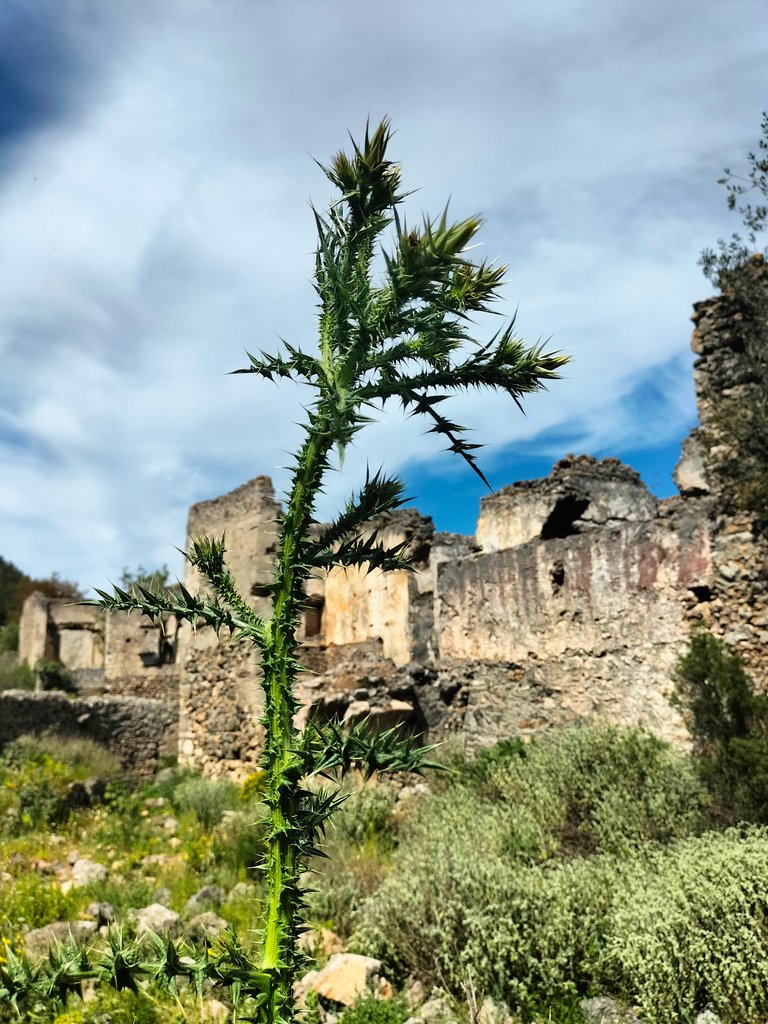

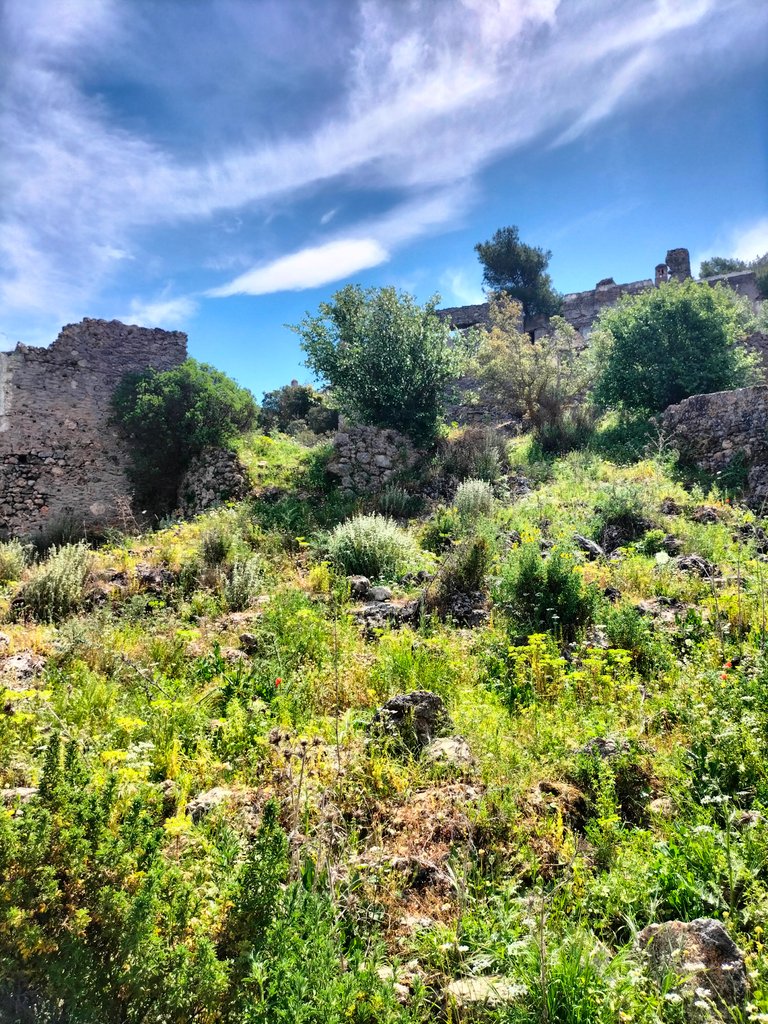

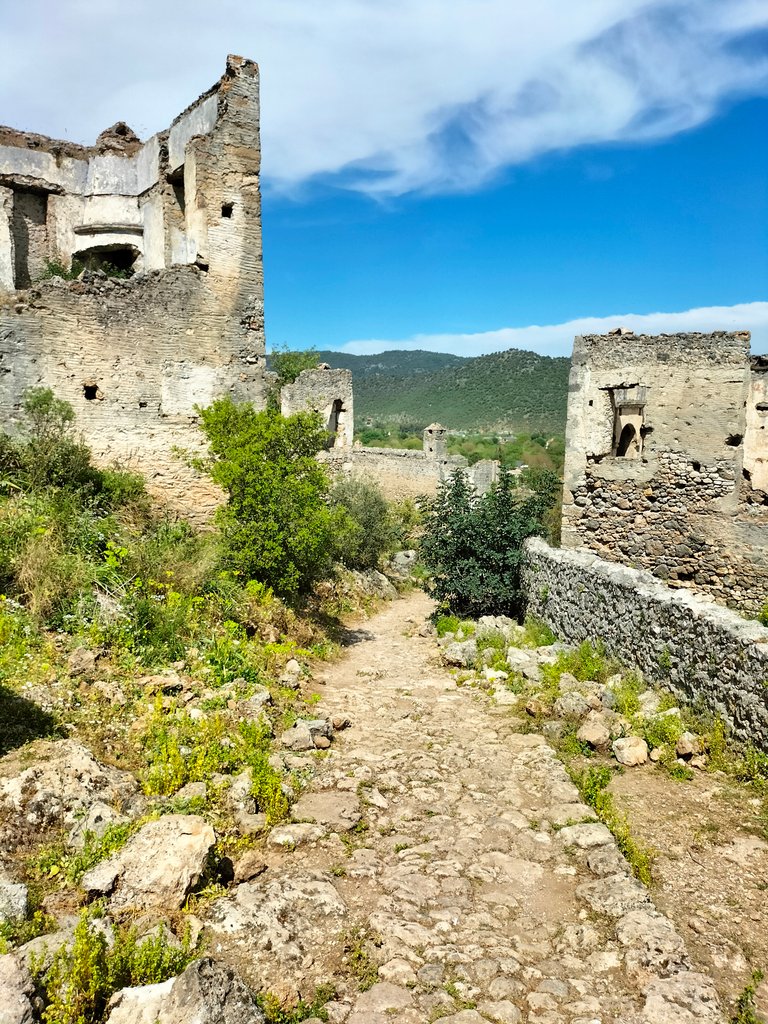

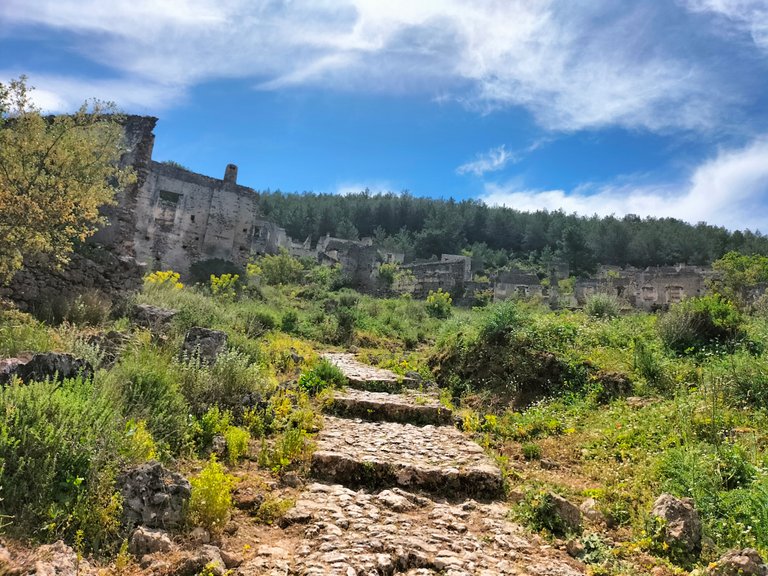
As you walk along the stone-paved side streets towards the mountainside, you imagine the lives lived in abandoned houses. I think that people live a tolerant and loving life in these houses built without obstructing each other's views. The quiet and dead state of this town, where hundreds or more people live, is heartbreaking. As we walk, we come across houses with broken or missing roofs and windows. Colorful images of different flower species growing around try to keep this place alive.
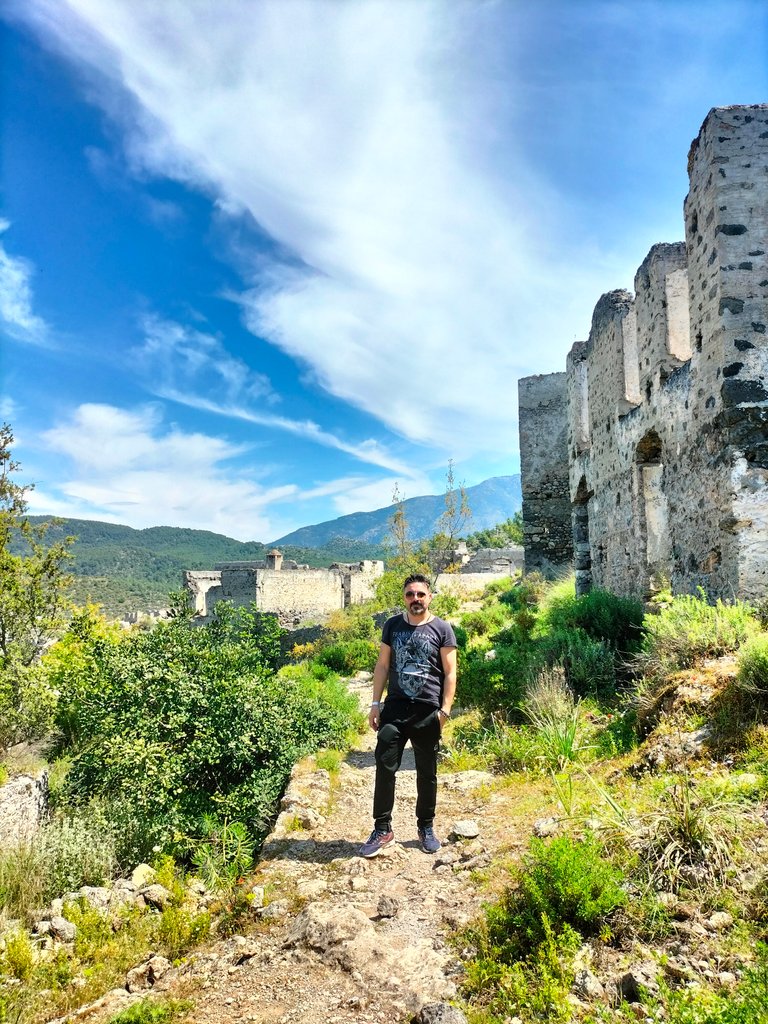

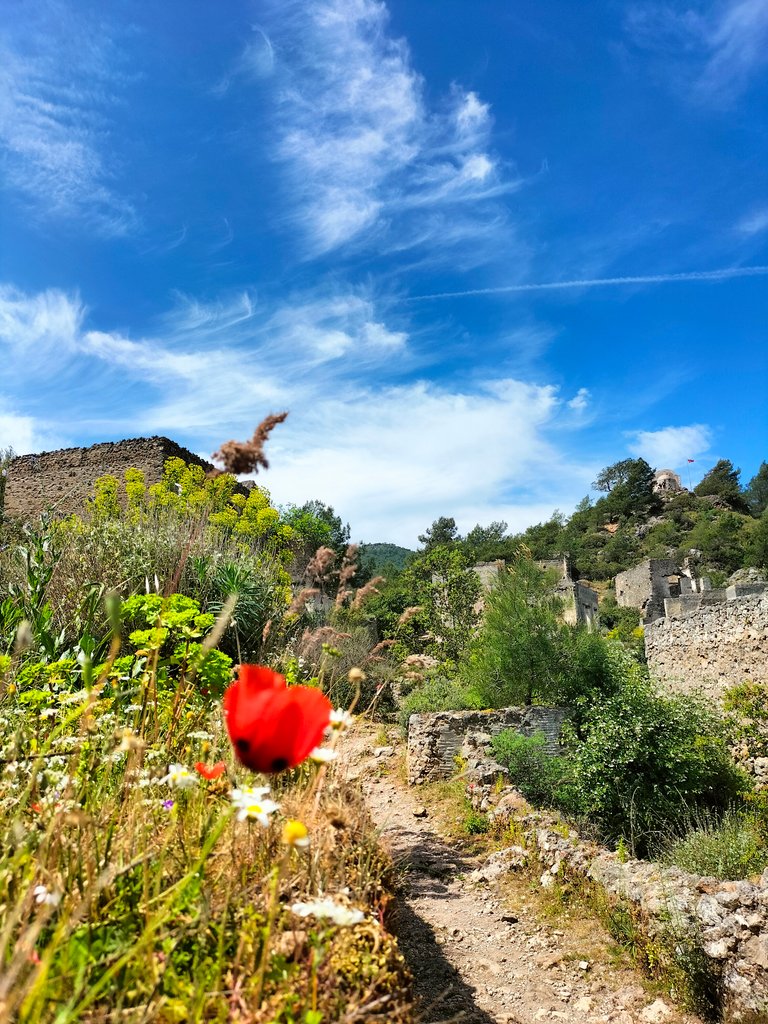

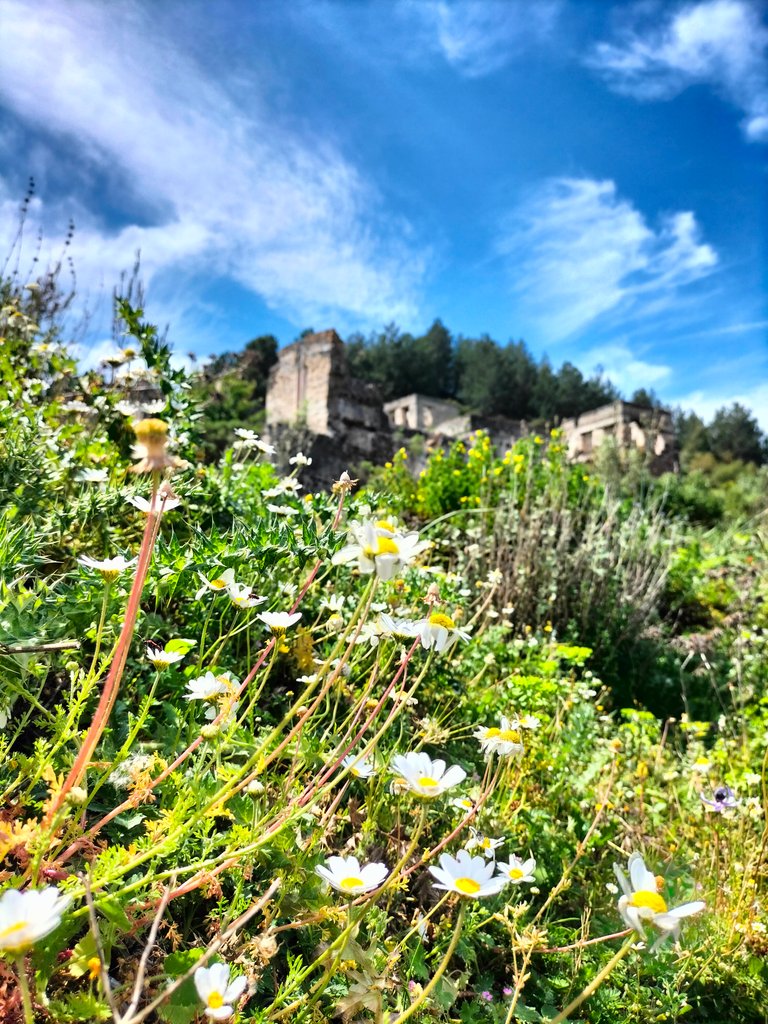
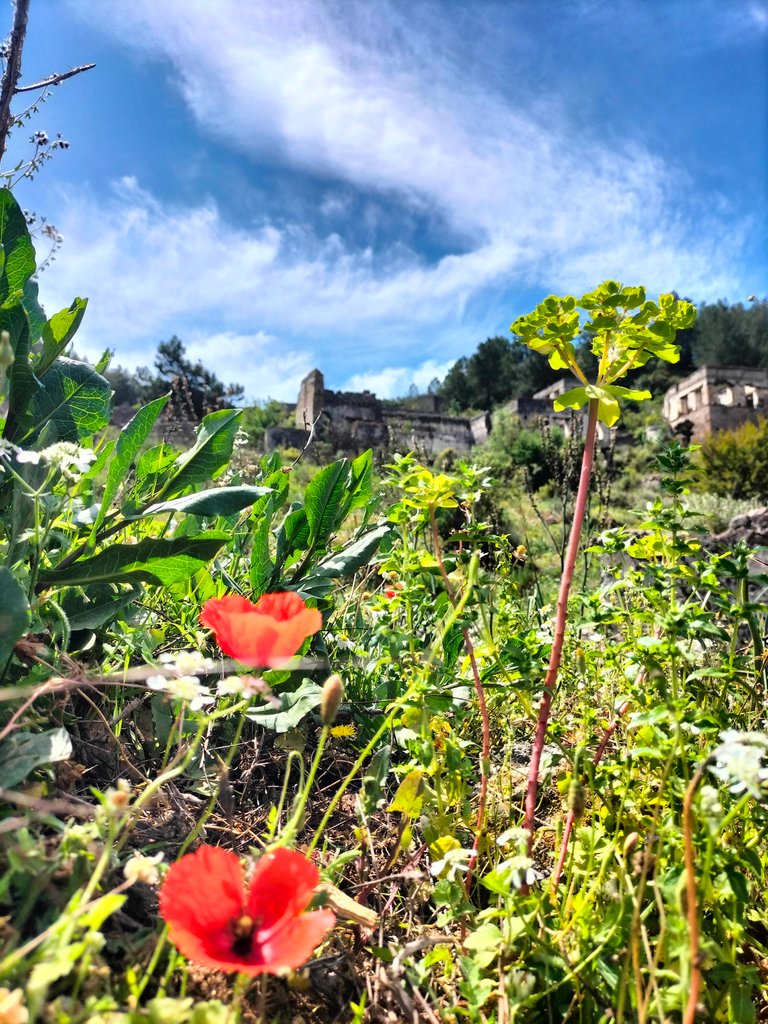


When we reach the top, Kayaköy (Levissi) is right under your feet. On one side, you can see all the houses, and on the other hand, you can see that magnificent view where green and blue meet. I see that there is a chapel building at the top that resembles a mill structure.
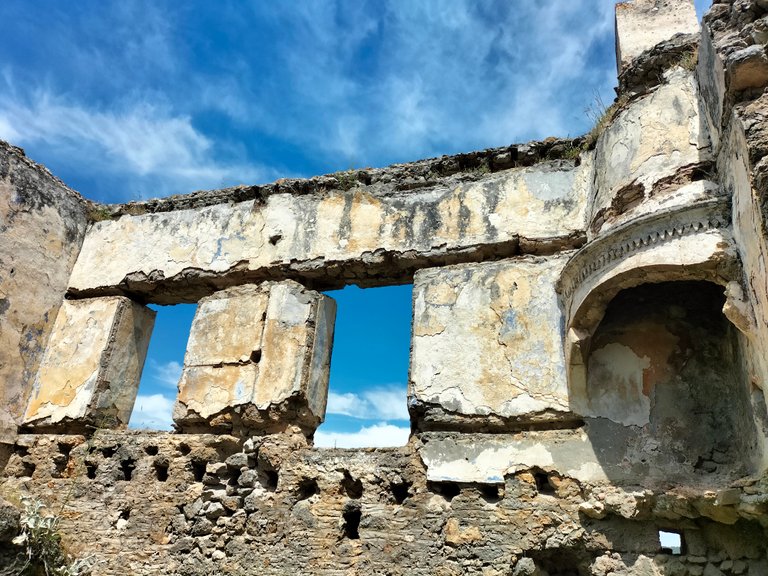


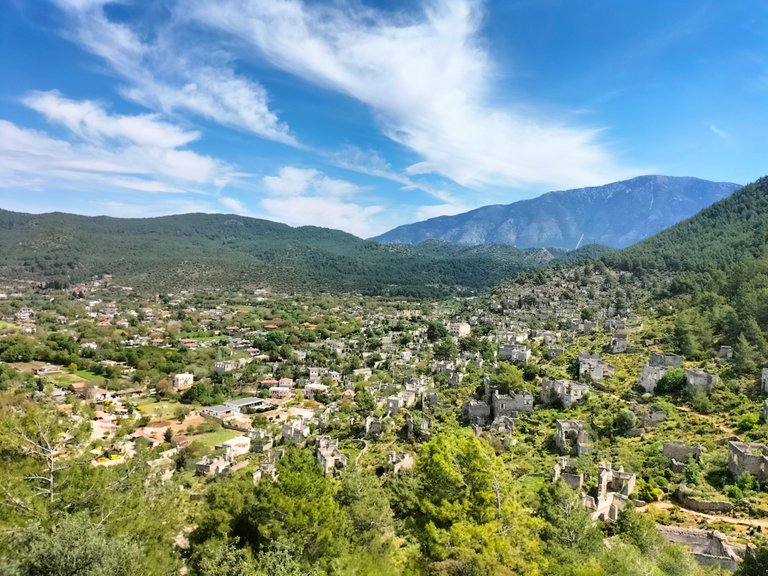
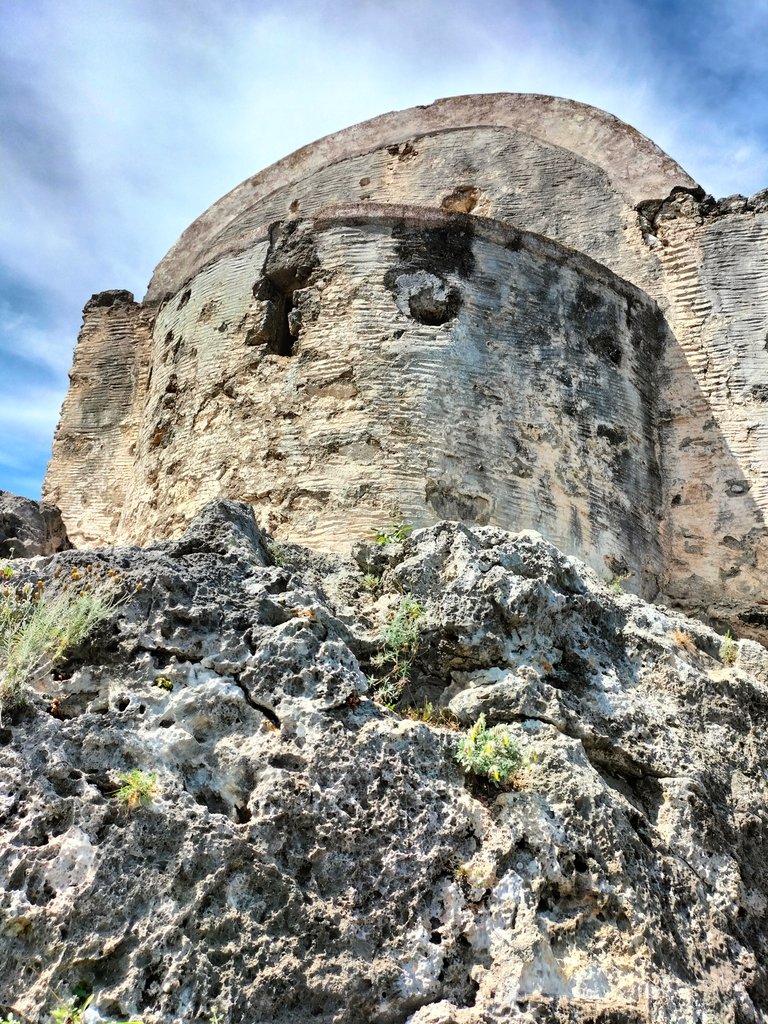
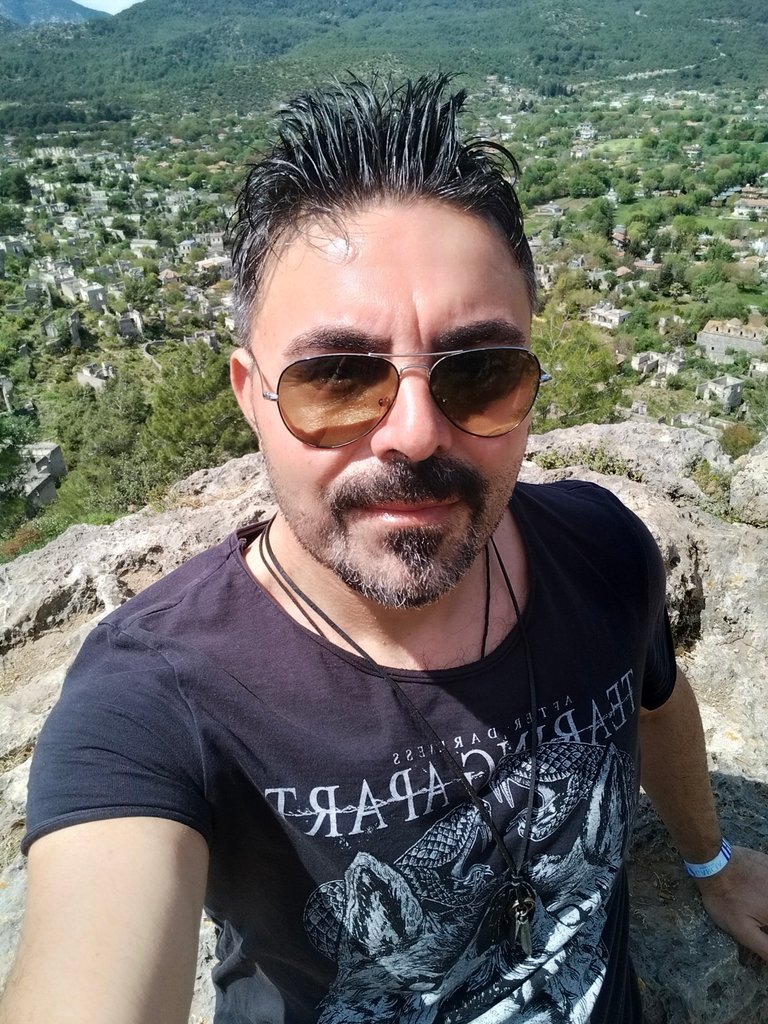
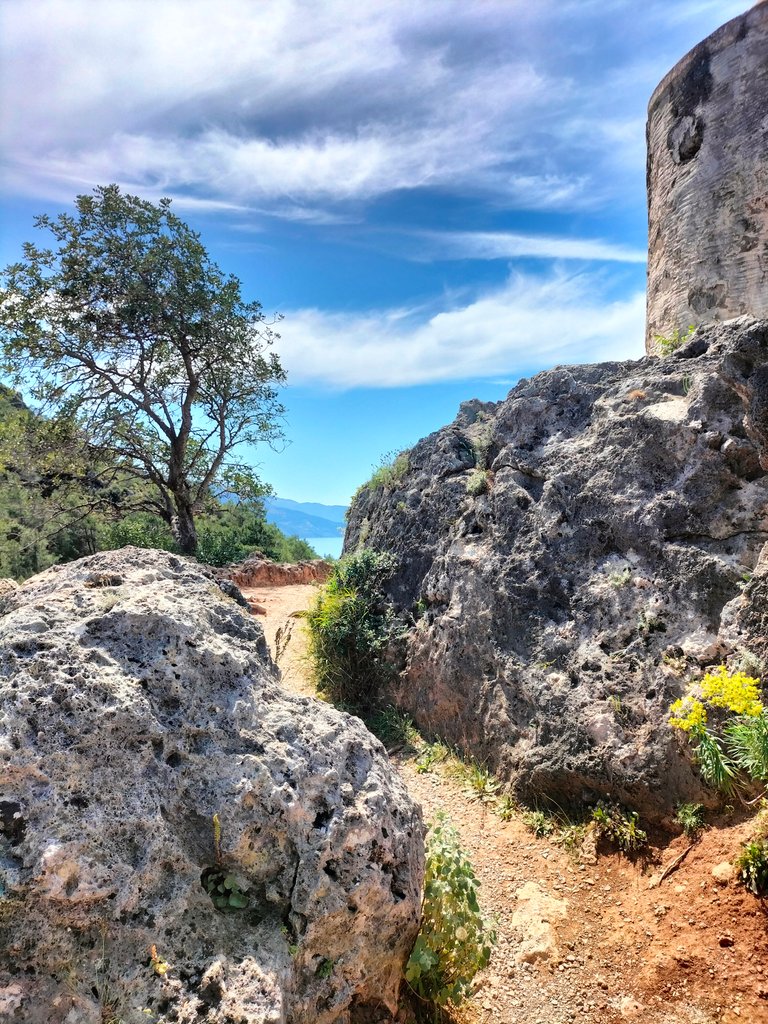
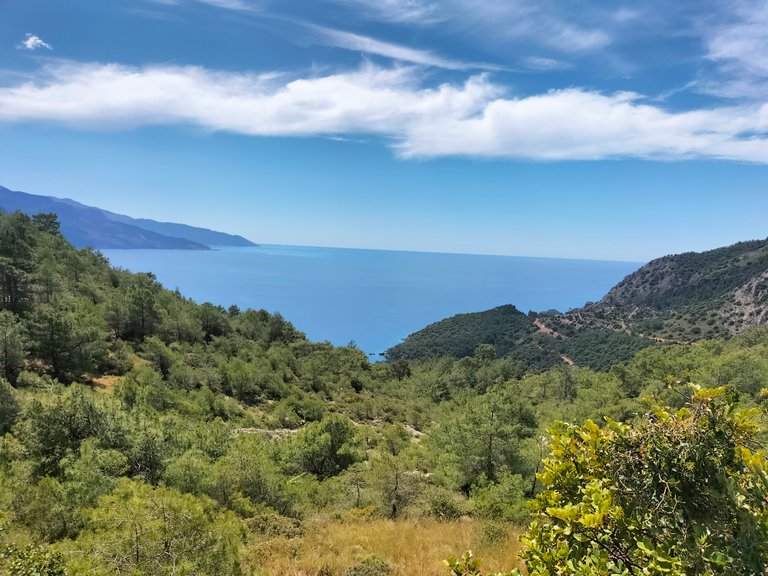


From here we say goodbye to the thousand-century-old Kayaköy (Levissi), where we traveled to the past and felt the lives lived with sadness. Thank you so much for staying with me. Look at life smilingly with happy hearts, see you on other trips.
TR
Merhaba, Sevgili Gezginseverler,
Bugün sizlerle bir tepe yamacına kurulmuş, yarısı hasar görmüş, yarısı da tamamen yıkılmış tarihi evlerin geçmişine uzanacağız. Dağ yamacını tamamen kaplayan bu hayalet köyü görünce, bu evlerde biriken anıları da içimde hissetmeye çalıştım. Fethiye'de belki de çok gelinen bir nokta değil ama, gördükten sonra herkesi büyüleyebilecek nadir noktalardan biri olduğunu düşünüyorum.





Muhteşem bir doğanın ve yeşilliklerin içinde, küçük kaya parçalarını andıran yıkılmış evleri görünce, hayran kalacağınıza eminim. Şimdi çatısız, boyası olmayan bu dökülmüş evlerin her köşesinde köşe bucak dolaşarak, tarihine ve tüm güzelliklerine uzanacağız. Ama önce buraya nasıl geldiğimize değinelim. Eğer buraya uçakla gelmek isterseniz, en yakın Türkiye'deki Dalaman Havalimanını kullanabilirsiniz. Kayaköy, yani Hayalet Köy, Muğla ilinin Fethiye ilçesinde yer alıyor. Fethiye şehir merkezinden kendi aracınızla yaklaşık 10 dakikada buraya ulaşabilirsiniz. Konum olarak da Fethiye ve Ölüdeniz arasında kalıyor. Fethiye'den yola çıktığınızda, Kayaköy'e giden yolu takip edip edip, bir kaç virajlı dağ yolunu geçtikten sonra buraya ulaşabilirsiniz. Benim gibi, Antalya'dan Ölüdeniz'e gelip, Kayaköy'e gitmek için, Hisarönü mahallesinde geçip buraya rahatlıkla ulaşabilirsiniz.







Kayaköy'ün hemen girişinde çok güzel bir işletme var. Ağaçların ve yeşilliklerin arasına konulan minderli oturma kabinleriyle dikkat çekiyor. İçeride her türlü hem köye özgü hem de herkesin ilgisini çekebilecek hediyelik eşyalar satılıyor. Buradan girerek, gişe alanına geliyoruz. Hayalet Köy'e giriş ücreti olarak 85 TL talep ediyorlar. Yani, yaklaşık 8 Hive olarak düşünebilirsiniz. Gişeden geçtikten sonra hemen sol tarafta tarihi bir Kilise bulunuyor. Aşağı Kilise olarak bilinen bu tarihi kilisenin içine girişleri yasaklamışlar. Çok önceden kilise cami olarak kullanılıyormuş, sonradan kiliseye dönüştürülmüş. Yüksek duvarlarla çevrilmiş olan kilise, siyah ve beyaz eski taşlardan desenli mozaikler kullanılarak yapılmış. Kapı ve pencerelerinde mermer kullanılmış. Pencereler demir örgülerle kapatılmış. Çatısında yan yana duran kısa beş adet kısa kemerli giriş bölümleri var. Çatının ortasına yuvarlak minare başlığında geniş bir kapak yapılmış. Giriş kapısının önündeki desenli mozaik taşların itinalı bir şekilde yapıldığı görülüyor. Kilisenin içine giremesem de uzaktan da olsa bazı fotoğraflarını sizler için çekmeye çalıştım.












Her zaman tarihi yerleri gezmeye geldiğimde anı olarak kalması için mutlaka bir magnet veya herhangi bir hediyelik eşya alıyorum. Buradan da iki tane magnet alarak ören yerine giriş yaptık.





Gişenin hemen yanından taşlı geniş yoldan köye girişimizi yapıyoruz. Etrafı gezmeye başlamadan önce Kayaköy hakkında bilgilendirme panosunda neler yazdığına göz atalım.

Burası, antik dönemde Karmylassos olarak bilinen Kayaköyü'nün geçmişi filolojik verilerine göre M.Ö 3 binlere kadar gitmesine rağmen kalıntılarda M.Ö 4. yy.'dan daha eskiye giden buluntu henüz ele geçirilmemiş. Kentin yamacında kurulmuş olan evler, 19. yy.'ın ikinci yarısı ile 20. yy.'ın ilk çeyreğinde yapılmış olan ve o yıllardaki adı Levissi olan Rum yerleşimine aitmiş. Birbirini manzara ve ışık açısından engellemeyen ve çoğunluğu 50 m2 ölçülerinde olan evlerin yanında 14 şapel, 2 kilise, 2 okul binası ve 1 gümrük binası bulunuyor. Evlerin genellikle penceresiz ve alçak olan bodrum katlarında deri üretiminde kullanılan çukur elemanlar bulunmaktadır. Evlerin hemen her odasında ısıtma ve pişirmede kullanılan ocaklar ve çevresinde yüklüler olduğunu da öğreniyoruz.




Girişte, bir iki yerli esnafla konuştuğumda buraya tam da mevsiminde geldiğimi söylemişti. Gerçekten de öyle oldu. Nisan ayının ortasında, baharın, doğaya sunduğu o güzelim çiçeklerini ve yeşilliklerini yıkılmış evlerin arasından ve taşların arasından görme fırsatını da yakalamıştık. Terk edilmiş evlerin bahçesinde yetişen ağaçların, tohumunu ekenlerin, meyvelerini göremeden buralardan göç etmesi, bizleri gerçekten acıklı bir hikayenin ortasında bırakıyor. Kayaköy, bir dağ yamacına kurulmuş. Yıkılmış ve hasar görmüş Rumlardan kalan evler, yamaç boyunca sağlı sollu karşımıza çıkıyor. En tepede, Türk bayrağının olduğu, değirmen yapıyı anımsatan tarihi bir yapı var.







Köyün içinde kaya taşlardan oluşan girintili ve çıkıntılı dik yollar var. Bu yollar bizi evlerin bahçelerine götürüyor. Bahçe aralarındaki kayaların ve evlerin içinde kendine yer edilen bitki otların kokusunu alabiliyorsunuz. Rumların yaptıkları taş evlerin arasında dolaşarak, yıkılan ve terk edilen her yapının birbirine benzediğini söyleyebilirim. Köyün dar taş sokaklarından yürüyerek manzaranın en güzel olduğu tepeye ulaşmaya çalışıyoruz. Yürürken evlerin ve etrafındaki güzelliklerin de tadını çıkarıyoruz.







Bu terk edilen köyde evlerin çoğu iki katlı olup, bazı evlerin giriş bölümünde, su biriktirmek için yapılan depolar bulunuyor. Büyük ihtimalle Rumlar, yağmur sularını toplayabilecekleri bir alan oluşturmak istemişler. Dar dik kaya taşlı yollarda yürürken, etraftaki yeşilliğin cazibesine kapılıyorsunuz. Aralarda bulunan farklı ağaç türlerinin de olduğunu fark edebilirsiniz. Bu yeşilliğin ve ağaç türlerin bol olmasını, Ege suların ve Akdeniz sularının kesiştiği bir bölgede olmasından kaynaklandığını düşünüyorum. Yeşilliklerin arasından yamaca doğru dizilen evlerin beyaz bulutlarla birlikte görünmesi, sanat eseri taşıyacak resimleri ortaya çıkarıyor diyebilirim.








Dağın yamacına doğru yol boyunca, taş döşemeli ara sokaklarda yürürken, terk edilen evlerde yaşanan hayatları hayal ediyorsunuz. Birbirinin manzarasına engel olmadan yapılan bu evlerde insanların hoşgörülü ve sevgi dolu bir yaşamın içinde olduğunu düşünüyorum. Yüzlerce belki de daha fazla insanın yaşam sürdüğü bu kasabanın sessiz ve ölü hali, insanın içini parçalıyor. Yürüdükçe karşımıza çatıları ve pencereleri dağılmış ya da yok olmuş evler çıkıyor. Etrafta yetişen farklı farklı çiçek türlerinin rengarenk görüntüleri burayı ayakta tutmaya çalışıyor.








En tepeye vardığımızda, Kayaköy ( Levissi ) ayaklarınızın altında oluyor. Bir taraftan evlerin tamamını, bir taraftan da yeşille mavinin buluştuğu o muhteşem manzarayı görebiliyorsunuz. En tepede değirmen yapısını anımsatan bir şapel binası olduğunu görüyorum.










Geçmişe yolculuk yaptığımız ve yaşanan hayatları hüzünle hissettiğimiz bin asırlık Kayaköy'e ( Levissi ) buradan veda ediyoruz. Benimle kaldığınız için çok teşekkürler. Başka gezilerde buluşmak üzere, mutlu dolu yüreklerle hayata gülümseyerek bakın.
Congratulations, your post has been added to Pinmapple! 🎉🥳🍍
Did you know you have your own profile map?
And every post has their own map too!
Want to have your post on the map too?
Yazıyı okurken bir rehber tadında bende gezdim keyifli bir yazıydı emeğine sağlık
Çok Teşekkür Ederim:)) Geride bırakılan anıların izlerini görebilmek ve onları hissetmek benim içinde güzel bir deneyim oldu.
Gerçekten büyüleyici bir yer. Hatta bana biraz korkunç gelmişti. Çok güzel bir yazı olmuş
Hiya, @ybanezkim26 here, just swinging by to let you know that this post made it into our Top 3 in Travel Digest #2204.
Your post has been manually curated by the @pinmapple team. If you like what we're doing, please drop by to check out all the rest of today's great posts and consider supporting other authors like yourself and us so we can keep the project going!
Become part of our travel community:
I thought it only existed in movies. I wonder how the people lived there a long time ago. But, as you mentioned, maybe they live a loving life there. It's nice of you to visit this place.